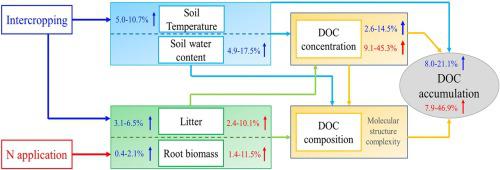Soil and Tillage Research ( IF 6.1 ) Pub Date : 2021-03-02 , DOI: 10.1016/j.still.2021.104979 Ding Wang , Wenbo Yi , Yanli Zhou , Shuran He , Li Tang , Xinhua Yin , Ping Zhao , Guangqiang Long

|
Soil dissolved organic carbon (DOC) plays a critical role in migration and transformation of soil organic carbon. For revealing effects of intercropping and N application on dynamics of DOC concentration and chemical structure, a multi-year located field experiment with cropping patterns (maize monocropping and maize-potato intercropping) subjected to four N levels (0 kg ha−1, 125 kg ha−1, 250 kg ha−1, 375 kg ha−1) was conducted. The results showed that N application raised DOC concentration while DOC accumulation, had a quadratic relationship with N application rate during the entire growth period of maize. At the same N level, intercropping increased the concentration and accumulation of DOC compared with monocropping. Meanwhile N application promoted the contents of amines and aromatic compounds and average molecular weight of DOC molecules, which reached the highest value at rate of 125 kg N ha-1. Compared with monocropping at the same N level, there was a tendency to increase the content of amines and aromatic compounds and the average molecular weight of DOC in intercropping, thus improving the degree of humification and aromatization of soil DOC. Soil temperature, water content and NH4+-N were the main factors mediating DOC concentration, while DOC concentration and soil temperature significantly affected the chemical structure of DOC. The structural equation model showed intercropping and N application elevated soil DOC concentration by increasing soil temperature, litter and root biomass, and the improvement of DOC concentration and soil temperature further enhanced the average molecular weight of DOC, resulting in accumulation of DOC.
中文翻译:

间作和施氮增加了化学成分复杂的土壤中溶解性有机碳的浓度
土壤溶解有机碳(DOC)在土壤有机碳的迁移和转化中起着至关重要的作用。间作和DOC的浓度和化学结构的动力学氮肥的揭示效果,多年位于场实验进行4 N级(种植模式(玉米单作和玉米马铃薯间作)0公斤公顷-1,125公斤公顷-1,250公斤公顷-1,375公斤公顷-1)进行。结果表明,在玉米整个生育期内,氮肥的施用增加了DOC的浓度,而DOC的积累与氮肥的施用量呈二次关系。在同一氮水平下,与单作相比,间作增加了DOC的浓度和积累。同时,氮的施用促进了胺和芳香族化合物的含量以及DOC分子的平均分子量,在125 kg N ha -1的条件下达到了最高值。与相同氮水平下的单作相比,间作有增加胺类和芳香族化合物含量以及DOC平均分子量的趋势,从而提高了土壤DOC的增湿和芳构化程度。土壤温度,水分和NH 4 +-N是影响DOC浓度的主要因素,而DOC浓度和土壤温度显着影响DOC的化学结构。结构方程模型表明,套作和施氮增加了土壤温度,凋落物和根系生物量,从而提高了土壤DOC的浓度,DOC浓度和土壤温度的提高进一步提高了DOC的平均分子量,从而导致了DOC的积累。











































 京公网安备 11010802027423号
京公网安备 11010802027423号